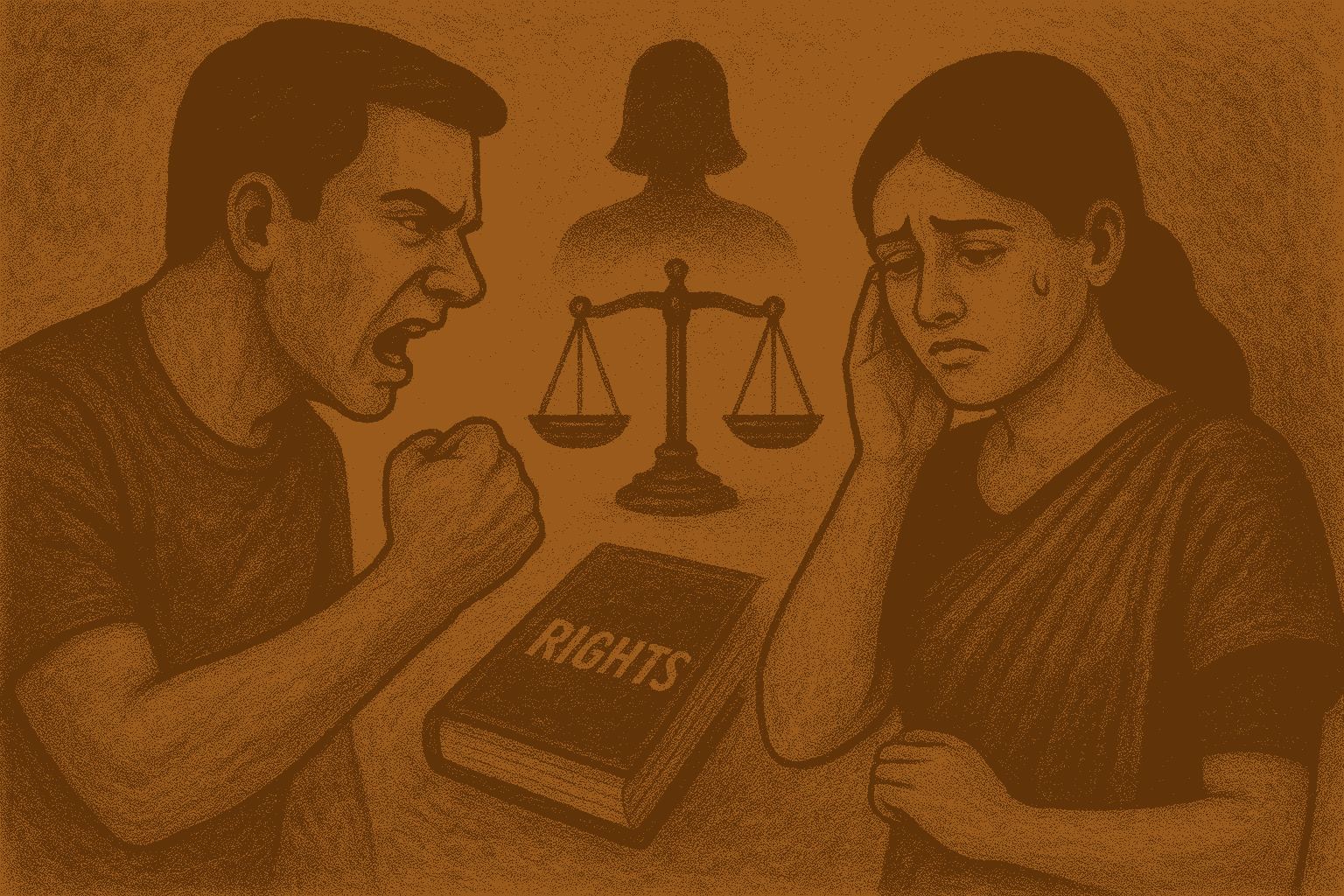The gender rights debate has been chiefly about protecting women against discrimination and abuse. There is a recent shift in focus, however, towards greater awareness of men’s rights and the abuse of safeguard statutes by women. This research work explores legal rights of men against women and considers statutory safeguards, case law interpretations and issues of concern. It also critically analyzes the socio-legal realities which underpin a balanced gender justice model.
This article examines men’s legal right in different countries such as the us, the uk, Australia, and Scandinavia and contrasts it with the scenario in India. It locates gaps, reforms, and socio-legal obstacles. Overview of gender equality movements, Historical neglect of men’s rights issues, Goal of study: analyzing legal protections and empower of men worldwide and in India. Significant Legal Rights of Men
Keywords Men’s rights, abuse of law, gender justice, domestic violence, false cases, and legal remedies
1. Introduction
Legal frameworks in most parts of the world, even in India, have long been focused on protecting women from violence, harassment, and discrimination alone. However, with the changing contours of society, there is a greater realization that laws that were put in place to protect women sometimes end up being misused and do harm to innocent men. This article delves into the legal safeguards and the options available to men in case of abuse by women and with a focus on the Indian context.
The need to gender-neutral laws as a defense shield for men has been long propagated in the interest of maintaining the very essence of equality under Article 14 of the Indian Constitution. While acknowledging the past centuries of oppression of women, the current study examines the recent problems where men happen to be victims of abuse of law.
2. Legal Provisions Available to Men
2.1 Protection from False Criminal Cases
Section 233 of the BHARATIYA NYAYA SANHITA, 2023 (BNS) – False Charge of Offense the Indian Penal Code Section 233 criminalizes false accusations. Under the section, a man may be prosecuted if a woman falsely institutes criminal proceedings against him with malicious knowledge.
Punishment for its Prison sentence of up to seven years and fine.
Section 182 of BHARATIYA NYAYA SANHITA, 2023 (BNS) – Giving False Information to a Public Servant:Section 182 BHARATIYA NYAYA SANHITA, 2023 (BNS) can be invoked in case of a woman providing untrue information to the police with the intention of causing harm to a man.
Sections 354 and 355 BHARATIYA NYAYA SANHITA, 2023 (BNS) – Defamation a male defendant can pursue a defamation case if he is wrongfully accused by a woman whose comments damage his reputation.
Case Law : Subramanian Swamy v. Union of India, (2016) — the Supreme Court upheld the constitutionality of criminal defamation.
2.2 Domestic Violence Act and Men
The Protection of Women from Domestic Violence Act, 2005 (PWDVA) is predominantly woman-centered. There have, however, been demands of a gender-neutral domestic violence law. Currently, men have very limited recourse under PWDVA in most circumstances. The following may be applied nonetheless:
Article 226 Writ Petition: Falsely implicated men can approach the High Court. Civil Actions: Malicious prosecution damages may be pursued by men.
2.3 Protection under Baritya nagrik suraksha sahita (BNSS)
(a) Section 484 of Bartya nagrik suraksha sahita (BNSS) – Anticipatory Bail Male defendants accused of non-bail able offenses such as harassment because of dowry (Section Bharatiya Nyaya Sanhita,, 2023 (BNS)) or sexual harassment may file anticipatory bail to avoid arrest.
Case Law Arnesh Kumar v. State of Bihar, 2014 — Supreme Court guidelines not to arrest automatically under 85, Bharatiya Nyaya Sanhita, 2023 (BNS)
(b) Section 528 Bartiya nagrik suraksha sahita (BNSS) – Inherent Powers of High Court High Courts do possess the power to set aside false F.I.R.s to prevent misuse of the judicial process.
2.4 Misuse of Dowry Law – Section 85 Bharatiya Nyaya Sanhita, 2023 (BNS)
Originally intended to check dowry deaths, Section 85 of the Bharatiya Nyaya Sanhita, 2023 (BNS) is being misused routinely against husbands and their families
– Misuse was observed by the Law Commission of India (243rd Report).
– Supreme Court instructed that family welfare committees should be set up to hear cases of complaint before arrest is made.
3. Judicial Acceptance of Men’s Rights
On various occasions, the Indian judiciary has accepted the ordeal of men falsely implicated.
Case law Arnesh Kumar v. State of Bihar (2014):
No arrest in Section 85 Bharatiya Nyaya Sanhita, 2023 (BNS) should be automatic. Rajesh Sharma v. State of Uttar Pradesh (2017): Guidelines to prevent abuse of 85 include the setting up of Family Welfare Committees
Preeti Gupta v. State of Jharkhand (2010): The Supreme Court did acknowledge the growing number of Section 85 false case instances.
4. Issues and Challenges
4.1 Lack of Gender-Neutral Legislation
The majority of the safeguarding laws, for instance, PWDVA and Section 354 of the Indian Penal Code (outraging modesty), largely give priority to safeguarding women with little room to safeguard men. 4.2 Social Stigma
Men do not readily come forward against abuse and harassment out of concern of ridicule and societal pressure. Limited NGO and Support Systems Unlike women’s rights organizations, few organizations are currently operating to assist male victims of abuse of law.
5. International Outlook
Numerous nations have introduced gender-neutral legislation:
United States: Domestic violence laws are largely gender-neutral.
United Kingdom: Protection is provided to men by domestic violence legislation.
Australia: Equal Opportunity Commissions react to male victimisation
India is still grappling with setting similar inclusive laws.
6 Legal Rights of Men in a Global Context
Whereas gender equality has predominantly been concerned with the rights of women because of historical and structural discrimination against them, men’s legal right, particularly in family legislation, equality in the workplace, and protection against gender violence, has been gaining increasing importance. This article examines men’s legal right in different countries such as the us, the uk, Australia, and Scandinavia and contrasts it with the scenario in India. It locates gaps, reforms, and socio-legal obstacles. Overview of gender equality movements, Historical neglect of men’s rights issues,, Goal of study: analyzing legal protections and empower of men worldwide and in India. Significant Legal Rights of Men: A International Perspective: Family Law, Custody and Parental Rights:United States/UK/Australia: Mutual parenting gaining traction; fathers have increasing legal rights to custody and visitation.
Scandinavia: Accent on equal parenting roles post-divorce.India: Courts still favor mothers in custody battles, especially for young children, though joint custody is now considered.Global: Countries like Canada and the UK have due process protections, but face challenges in balancing rights of accused with protection of victims.India: Men can face arrest without investigation under laws like BHARATIYA NYAYA SANHITA, 2023 (BNS) Section 85 (dowry harassment), though courts have issued guidelines to curb misuse.
7. Protection from Domestic Violence
UK/Australia/USA: Domestic violence law is gender-neutral and male victims can lodge complaints.India: Protection of Women from Domestic Violence Act of 2005 is gender-specific and safeguards only women. No corresponding law exists for men.
As also discourse about working place harresment is Equal opportunity and gender-based discrimination protection is in most of the Western democracies and in India: No laws formally recognize victims of male sexual harassment under POSH Act of 2013; lacks gender neutrality and Paternity Rights and Parental Leave Scandinavian nations: Progressive paternity leave policies.,India: No legal requirement of paternity leave in private sector.Rise of Men’s Rights Movements Emergence of Men’s Rights Activism (MRA) around the worldAdvocating for:Equal parenting,Law reform to stop abuse of gender-based lawsPrevention of mental health and suicide and India: Organizations such as Save Indian Family Foundation campaign in support of legal reforms and in favor of falsely accused men.
8. Critical Evaluation
Although the protection of women was required to correct past wrongs, the pendulum cannot swing to such an extent that it creates an unjust environment for men. Legislation should be such that there is a balance of protection and prevention of abuse in the middle.
False allegations do not only eat into judges’ and prosecutors’ time and money, but also trivialize genuine abuse cases. They destroy lives, careers, reputations, and families. Such legislative measures as:
– Enacting laws to make domestic violence gender-neutral
– Ensuring strict punishment to file frivolous cases
– Strengthening means of Family Courts to process matrimonial problems with sensitivity
are absolutely important to impart authentic gender justice.
Gender sensitization also has to embrace the fact that men can be victims.Legal Reforms Needed in India
Make domestic violence and harassment laws gender-neutral.
Enforce safeguards against misuse of gender-specific laws.
Recognize paternity leave and shared custody rights.
Create helplines and mental health support for men.
9. Conclusion
Gender justice is justice to all genders only. While continuing to protect women from violence remains of the highest priority, acknowledging and acting against abuse of safeguard laws against men is equally important. Equality is guaranteed by a balanced legal code and court sensitivity and societal awareness. It is time that India updated its legal codes so that neither the woman nor the man is denied justice on account of genders both women and men’s legal rights need to be addressed in achieving actual gender equality. Though most developed countries have gone a long way in achieving balanced legal systems in place, India is behind in having parity in parental rights, protecting men from domestic violence, and against malicious accusations. Progressive legal reforms and societal awareness need to be in place to promote equality before the law—irrespective of gender.
References
Ministry of Law and Justice, Government of India
https://legislative.gov.in
National Crime Records Bureau (NCRB)
https://ncrb.gov.in
India Code Portal
https://www.indiacode.nic.in
https://main.sci.gov.in
https://www.livelaw.in
Bar & Bench
https://www.barandbench.com
Save Indian Family Foundation (SIFF)
https://www.saveindianfamily.org
Men’s Rights India
https://www.mensrights.in
Equality and Human Rights Commission (UK)
https://www.equalityhumanrights.com
U.S. Department of Justice – Office on Violence Against Women (OVW)
https://www.justice.gov/ovw
Australian Human Rights Commission
https://humanrights.gov.au
Journals and Online Legal Publications
Journal of Indian Law and Society (JILS)
http://jils.ac.in
Law Review
https://nujslawreview.org
National Law School of India Review (NLSIR)
https://nlsir.com
SSRN – Social Science Research Network (Law & Gender Section)
https://www.ssrn.com
Indian Journal of Gender Studies – SAGE Journals
https://journals.sagepub.com/home/ijg
Government Reports
Law Commission of India, 243rd Report on Section 85 BHARATIYA NYAYA SANHITA, 2023 (BNS) (2012)
National Crime Records Bureau (NCRB) Reports
– Dr. Vidya Shaktawat (Professor)
Faculty of Law, Madhav University

